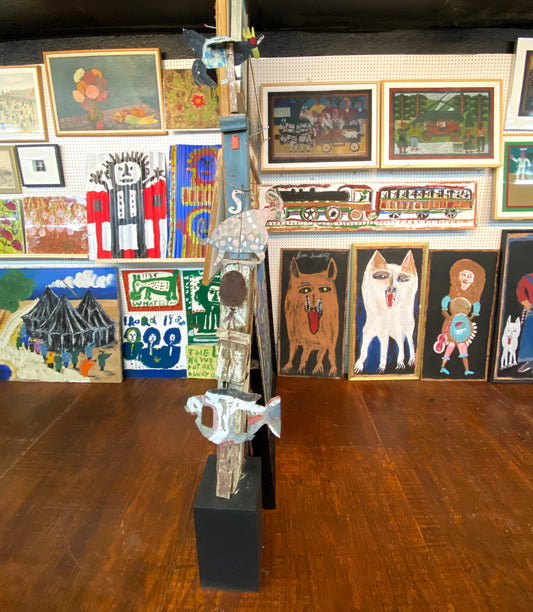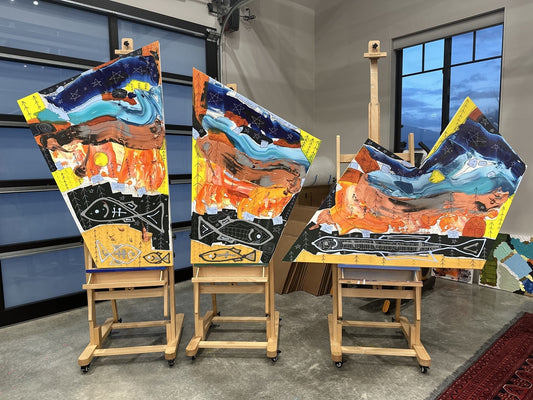Paul Laffoley
(1928–2016)
Thornton Dial, a giant among self-taught, African-American artists of the Deep South of the United States in the twentieth century, died at his home in Alabama on January 25, 2016. He was 87 years old. His survivors include his half brother, Arthur Dial; four adult children; and numerous grandchildren and great-grandchildren.

image © Matthew Arnett
Born in rural, west-central Alabama to a young, unwed mother from a poor family of sharecroppers, Dial found himself working in the fields by the age of six. “We picked cotton when we got big enough to walk... . I was just a little bitty something but I had to earn my way”, he once recalled. He was brought up by a great-grandmother who lived on the farm of one of his cousins, who used odds and ends in his yard to make sculptural assemblages. Thornton’s schooling ended at the third-grade level; he never learned to read or write. In the early 1940s, as a youth, he moved to Bessemer, Alabama, an industrial town near the larger city of Birmingham, where he worked at odd jobs before becoming employed at a factory that produced Pullman railway carriages.
There, he learned to weld. He married and, with his wife, Clara Mae, who died in 2005, had five children, one of whom died young. Instinctively tapping into the tradition of African-American “yard art”, which can be seen decorating the properties of black residents throughout the American South, Dial used found materials – metal and wood scraps, old wire, swatches of cast-off garments and more – to make sculptural constructions of his own. Such enigmatic creations were steeped in the African practice of creating talismanic objects or shrine-like assemblages to adorn and protect personal spaces, such as homes or gardens.

image © Matthew Arnett
In 1987, through the artist Lonnie Holley, another African-American autodidact, Dial met William S. Arnett, a white, Atlanta-based art researcher and collector who was deeply interested in the art of visionary, black, self-taught art-makers. The more he learned about their ideas and accomplishments, the more vocal a champion of their work the Georgia-born Arnett became. However, even as he became Dial’s main patron and worked tirelessly to call attention to these artists’ achievements, some of which had paralleled, anticipated or gone beyond contemporary developments in modern and postmodern art, the mainstream art establishment effectively blocked what could have been faster, fuller exposure for Dial’s art to broad, general audiences.
Nevertheless, by the time Arnett established the Souls Grown Deep Foundation in Atlanta in 2010 (to collect the work of black self-taught artists of the American South and promote it through publications and exhibitions), Dial’s work had been shown to critical acclaim in solo museum exhibitions around the US. His works have been acquired by the Museum of Modern Art and the Whitney Museum of American Art in New York, the Smithsonian American Art Museum in Washington, DC, and the High Museum of Art in Atlanta.
In his art, informed by his experiences as a black man faced with oppressive, institutionalised racism, Dial took on big themes – slavery, prejudice, the struggles of the downtrodden, war and the mysterious forces of nature. A celebration of hope and beauty can be felt in Dial’s work, too. A sense of belief in the dignity of the individual and in human beings’ innate ability to overcome, with determination and faith in themselves, injustice and hardship, seems to pulse through his art and strike a resonant chord with its admirers.
Years ago, Dial said, “I have learned a whole lot about drawing from my work at the Pullman factory. Designs was punched out in the iron and steelworks – big, beautiful pieces of steel start out with a little design. […] Everything in the world got a pattern. The mind got to see it, the hands got to make it.”
In New York, Marianne Boesky Gallery has become the commercial representative of Dial’s oeuvre. In late 2014, the Metropolitan Museum of Art in New York announced that it had accepted a donation of nearly 60 works of art from the William S. Arnett Collection of the Souls Grown Deep Foundation, including ten of Dial’s. A selection of works from this gift is scheduled to go on view at the museum in the near future.
by Edward M Gómez


